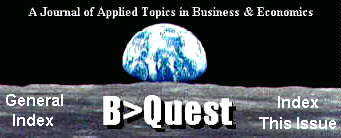|
|
|
January 29 , 2003 |
|
|
|
January 29 , 2003 |
Amidst reviewing last year's forecast, discussing President Bush's stimulus package and assessing the problems in Georgia at the beginning of Governor Perdue's tenure, I forgot to discuss my own outlook for 2003. How can I be graded if I do not hand in my homework.
Of course, I probably was trying to avoid a very
difficult task. Three major
"geopolitical" uncertainties cloud the horizon.
Venezuela oil has been absent for 52 days, and the promised additional
oil from the Middle East is nearly a month away.
With cold air descending, relief from higher energy prices will not
happen before we begin to see daffodils.
An Iraq conflict probably will lead to oil field
destruction in that country (see Kuwait twelve years ago) as well as
immeasurable economic and human costs. Under
some possibilities, even that Venezuela make-up oil from the Middle East could
stop if the conflict turns nasty.
Then there is North Korea and what must be done in that
part of the world to maintain stability but register firmness.
At a minimum, some diplomatic magic is needed there.
To add to the uncertainties, tax policy will be changed
but portions of the proposal, such as the dividend exclusion, are in serious
jeopardy. Even the President is
ignoring dividend exclusions in his sale of the package as an aid to small
business.
Unfortunately, these uncertainties are restraining the decision making of corporations. Three years ago, Intel was spending $7.1 billion on capital spending. Projections for 2003 are only $3.5 billion. Parked airplanes, unfinished wireless networks, abandoned power plants, and rapidly emptying office space attest to a serious glut of resources. Profits are up about 9% in the fourth quarter, but from a 21% decline in the previous year.
To further dampen spirits, auto sales are losing their
responsiveness to new incentives, the average worker's raise is being left at
the gasoline pump and fuel oil deliverer, the strong housing market already is
ahead of household growth, and imports are overwhelming local producers.
As we can see in Georgia, higher taxes, lower government pay, and
reduced services are facing local economies.
The outlook for the next six months is unusually cloudy,
but I do see the sun shining before the end of the year. With no more hedging, here is my U.S. forecast for the next
twelve months.
Enough consumer spending, housing, and inventory building
will sustain activity through the spring.
By then, more clarity will surface on the "geopolitical"
issues. Also, capacity no longer
is growing. If jobs begin to grow
by summer, as I expect they will, corporate spending will begin to rebound.
Furthermore, the drastic slide in the dollar against
European currencies will lead to American goods being sold there.
Asia will be more difficult, but our trade balances should begin
improving later in the year. And some tax stimulus will be forthcoming.
(Given the uncertainties, it is needed, and ought to happen sooner
rather than later).
After less than 1 percent real growth last fall, I expect
GDP to slowly gain momentum through a 2 percent growth rate in the winter and
spring to more than 3 percent in the summer and almost 4 percent as the year
ends.
Inflation will remain muted except for oil and some meat
products. Consumer prices grew
only 2 percent at annual rates in the past three months but should spurt to
nearly 4 percent in the winter. Gains
of 2 to 2.5 percent should be the norm for the remainder of the year, with the
possibility of slightly less than 2 percent gains as gasoline prices subside
during the summer.
Until the fourth quarter, employment growth will not be
enough for the Federal Reserve to even think about raising interest rate
targets. If the current
uncertainties prove too constraining, they may even lower rates this winter.
Long term rates will remain near current levels (4 percent yield on the
ten year government note) until activity begins to hum late in the year.
Mortgage rates should remain under 7 percent into 2004.
Uncertainty is not the friend of stock investors.
Although seasonal factors currently favor equity holdings, the
"geopolitical" issues are canceling out those positive money flows.
That 9000 Dow hurdle may not be breached until summer, and then only
briefly. A more sustained rally
to challenge 10,000 is likely late in the fall.
Unemployment rates should rise to 6.5 percent before
beginning to subside late in the year. Wage
gains will remain anemic, at 3 percent in most shops and under 4 percent in
most offices.
Despite this less than robust economic recovery, some
healing will be accomplished. Households
will be saving about 6 percent of their income after the next reduction in tax
liabilities. Their balance sheets
also will continue the improvement begun last fall.
American industry will be competitive in Europe and will be fighting
back against competitive pressures in Asia.
Indeed, the weak dollar may aid the healing in South
America, although much more than economics is needed in Venezuela and
Columbia. New capital will
displace older systems, especially as corporate profits approach their 2000
levels by the end of 2003.
Thus, I see the glass as half full with a water source nearby. But we need to hold firmly onto that glass as we plough through "geopolitical" problems in the first half of this year.
